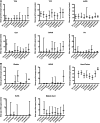Timing of Cardiac Surgical Interventions and Postoperative Mortality in Children With Severe Congenital Heart Defects Across Europe: Data From the EUROlinkCAT Study
- PMID: 38108249
- PMCID: PMC10863769
- DOI: 10.1161/JAHA.122.029871
Timing of Cardiac Surgical Interventions and Postoperative Mortality in Children With Severe Congenital Heart Defects Across Europe: Data From the EUROlinkCAT Study
Erratum in
-
Correction to: Timing of Cardiac Surgical Interventions and Postoperative Mortality in Children With Severe Congenital Heart Defects Across Europe: Data From the EUROlinkCAT Study.J Am Heart Assoc. 2024 Mar 19;13(6):e027766. doi: 10.1161/JAHA.122.027766. Epub 2024 Mar 18. J Am Heart Assoc. 2024. PMID: 38497464 Free PMC article. No abstract available.
Abstract
Background: The purpose of this study was to evaluate the timing of the first cardiac surgery, the number of cardiac surgeries performed, and 30-day postoperative mortality rate for children with severe congenital heart defects (sCHDs) in their first 5 years of life.
Methods and results: This was a population-based data linkage cohort study linking information from 9 European congenital anomaly registries to vital statistics and hospital databases. Data were extracted for 5693 children with sCHDs born from 1995 to 2004. Subgroup analyses were performed for specific types of sCHD. Children with sCHDs underwent their first surgical intervention at a median age of 3.6 (95% CI, 2.6-4.5) weeks. The timing of the first surgery for most subtypes of sCHD was consistent across Europe. In the first 5 years of life, children with hypoplastic left heart underwent the most cardiac surgeries, with a median of 4.4 (95% CI, 3.1-5.6). The 30-day postoperative mortality rate in children aged <1 year ranged from 1.1% (95% CI, 0.5%-2.1%) for tetralogy of Fallot to 23% (95% CI, 12%-37%) for Ebstein anomaly. The 30-day postoperative mortality rate was highest for children undergoing surgery in the first month of life. Overall 5-year survival for sCHD was <90% for all sCHDs, except transposition of the great arteries, tetralogy of Fallot, and coarctation of the aorta.
Conclusions: There were no major differences among the 9 regions in the timing, 30-day postoperative mortality rate, and number of operations performed for sCHD. Despite an overall good prognosis for most congenital heart defects, some lesions were still associated with substantial postoperative death.
Keywords: cardiac surgery; congenital heart defects; pediatric cardiology.
Figures


References
-
- Meza JM, Hickey EJ, Blackstone EH, Jaquiss RDB, Anderson BR, Williams WG, Cai S, Van Arsdell GS, Karamlou T, McCrindle BW. The optimal timing of stage 2 palliation for hypoplastic left heart syndrome: an analysis of the Pediatric Heart Network Single Ventricle Reconstruction Trial public data set. Circulation. 2017;136:1737–1748. doi: 10.1161/circulationaha.117.028481 - DOI - PMC - PubMed
Publication types
MeSH terms
LinkOut - more resources
Full Text Sources
Medical

